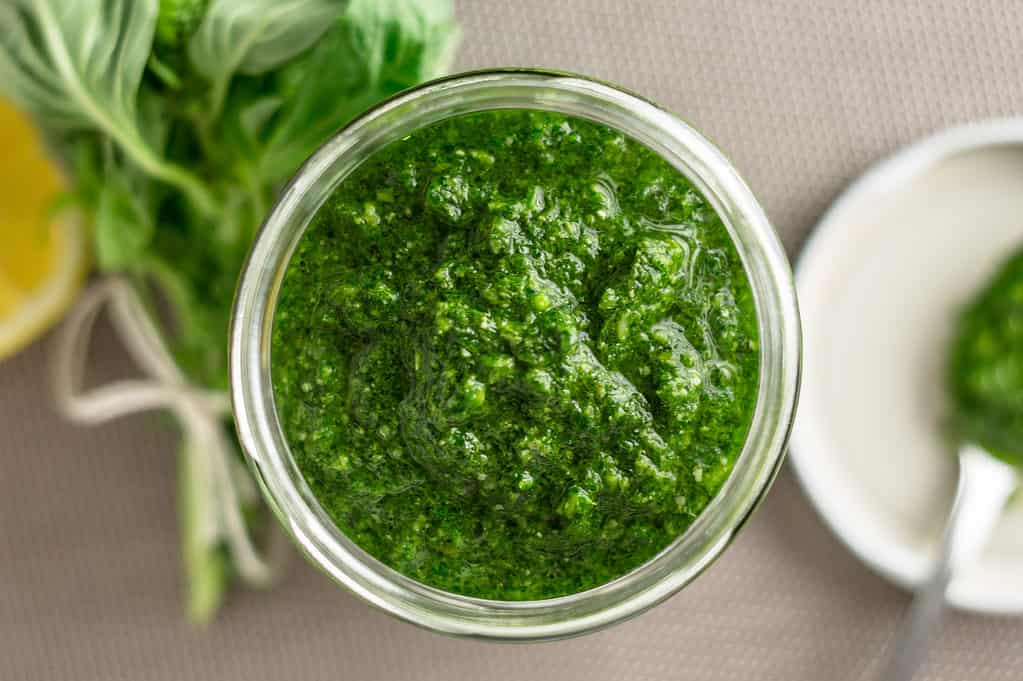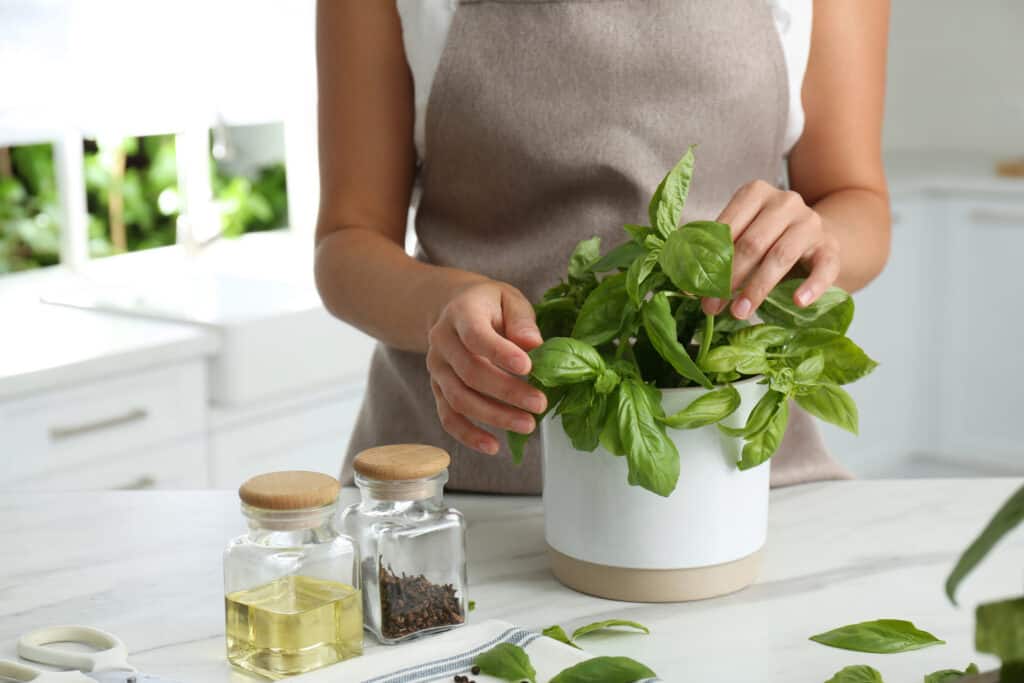Basil is one of the most popular herbs on the planet. In addition to its many culinary uses, it is also famous for its medicinal properties. There is a large variety of this popular herb, but the common and widely used version is often known as sweet basil with the botanical name of Ocimum basilicum.
Historians tell us that basil originates from India, but today the herb is cultivated on every continent around the globe.
The aromatic properties and medicinal benefits of basil leaves and stems have also resulted in the herb being used in many cultural activities and within several societies.
Why Grow Basil
Growing your own basil will provide you with a long list of physical and mental health benefits for you and your family. In addition, working with the soil in the fresh air has additional benefits and results in a healthy lifestyle.
It is not surprising that basil is referred to as the “holy herb” in many ancient cultures. Research shows the herb has many potent antioxidant, anti-inflammatory, and anti-bacterial properties. In addition to this, basil is packed with essential nutrients, minerals, and vitamins, including beta-carotene, vitamins A and K, and iron.
According to research, Holy basil, known as tulsi, is a popular herb in Ayurvedic medicine. This type of basil has many mental health benefits because it contains compounds that can assist in alleviating anxiety and depression. This herb also increases your ability to think clearly and lowers the risk of memory loss due to aging. Basil is also recommended to assist with cancer prevention, blood sugar regulation, and the prevention of heart disease.

Basil is a delicious herb with unlimited uses in the kitchen — from tasty drinks to pizza and pesto (pictured) — basil will enhance the flavor of your food.
©iStock.com/Louno_M
Cooking With Basil
In the culinary arena, sweet basil pairs well with tomato-based dishes, including pizza, pasta, and marinara sauce. Basil effectively neutralizes tomato acidity and enhances its natural sweetness. Italian chefs often use basil with parmesan cheese in their pasta dishes and salads.
Basil is so important in the Italian kitchen that they call it a symbol of love.
One will find basil used in the following ways:
- As whole leaves spread over pizza
- As a delicious garnish when sliced and sprinkled over pasta dishes
- Blended into sauces and soups
- Roughly chopped into salads
- The famous Italian Caprese salad will be incomplete without basil.
- As flavorful basil pesto
Basil is not only good for humans in the form of food and medicine, but it is also suitable for your garden as an excellent companion plant, and other plants benefit greatly from its presence. Because of its strong scent and taste, it will repel insects like aphids and whitefly from vegetables and fruit trees. In addition, you can make a very effective spray against insects and fungus from basil leaves.
If you need to know how to harvest basil, take a look at this step-by-step guide!
When Is the Best Time to Harvest Basil
You should start to harvest the basil leaves when the plant is young, and about 6 to 8 inches tall, as this is necessary because, at that stage, the plant’s leaves are still juicy and full of flavor. As the basil plant grows older, the plant becomes woody, and the leaves may become more rigid and less flavorful.
As the temperatures increase during the growing season, the leaves will grow faster, and the plants will become bushy and lush with the new leaves.
The best time to harvest basil leaves is in the early morning when the leaves are fresh and succulent. Regular harvesting of the leaves will stimulate the plant to grow further and produce more leaves throughout the growing season.

Prune your basil plant (pictured) from the top leaves to stimulate new growth.
©iStock.com/Liudmila Chernetska
Where to Cut Basil When Harvesting
1. How to Harvest Basil Leaves
When you require just a few leaves, the best way to harvest will be to just pinch the leaves off at the base of the leaves, starting with the larger leaves from the top of the plant. You should harvest a couple of leaves from each plant instead of taking too many leaves from just one.
Harvesting from multiple plants will result in all the plants growing more leaves and becoming more luscious and bushier. Remove any flower buds because if you don’t, the plants will start flowering, and the leaf growth will slow down. The flower buds can be thrown into your composting bins or used as a garnish for prepared meals.
2. How to Harvest Basil Stems
If you need more than just a few leaves, use a pair of pruning shears to cut the thicker stems. You should always start pruning from the top of the plant to stimulate the plant to develop new growth. You can easily prune back up to a third of the height of the plants, and in a couple of weeks, your basil plants will be ready to be harvested again. To encourage continuous growth in the growing season, you may want to feed the plants with an organic fertilizer to stimulate plant health and the development of lush foliage.
3. How to Harvest Basil Seeds
After the basil flowers have developed and started to die down, little seed pods will develop at the base of the flowers. After the pods have changed to a light brown color, they will be ready to get harvested. Be careful not to let the pods get too dry because then basil seeds are strewn all over your garden and herb planters.
Carefully cut off the seed pods and place them in a paper bag to dry out completely. The tiny black basil seeds will fall into the paper bag, and you can gather them to sow in the next planting season. You can sow the seeds directly into the herb beds or seeding trays. In colder areas, you must germinate the seeds indoors.

Today, basil (pictured) is cultivated on every continent in the world for its culinary uses.
©Billion Photos/Shutterstock.com
Replanting Basil Cuttings
While harvesting leaves and stems, you can also take some cuttings and place them in a glass of water. In a very short time, your basil cuttings will root, and you will have additional plants available for your garden. Before planting the new plants outside, plant them into pots. This allows them to harden off so that they can be strong enough to withstand the outside environment.
How to Store Fresh Basil
If you want to store fresh-cut basil for a few days, clip the branches and place them in water at room temperature. They will last up to five days in water on a kitchen surface. Do not place them in the fridge, as the leaves will quickly turn brown due to the cold temperature.
If you want to store fresh leaves in the fridge, the harvested leaves must be wrapped in some paper towel and placed in an airtight container first. Do not wash the leaves and wrap them in paper towels straight away. The leaves will turn brown in the fridge. Instead, ensure that the leaves are dried well before wrapping. This procedure will ensure that your basil leaves stay fresh and ready to use over two weeks.
Final Thoughts
Having read all about the rich and glamorous history of basil, I’m sure you are looking forward to having a bumper crop during the new growing season and experimenting with the various culinary uses of this versatile herb.
Basil is so easy to grow, and there is nothing like just walking into your own garden and picking some fresh leaves for your next meal.
The photo featured at the top of this post is © Elena Veselova/Shutterstock.com
Thank you for reading! Have some feedback for us? Contact the AZ Animals editorial team.






